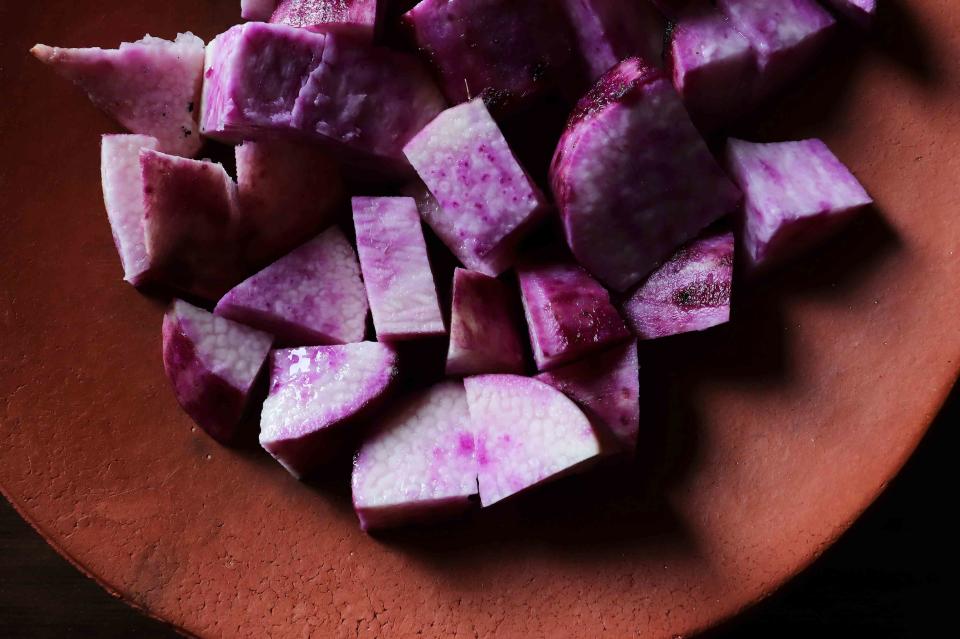Ube vs. Taro: What’s the Difference Between These Colorful Foods?
Make no mistake, ube and taro are not the same.

Veena Nair/Getty Images
Ube and taro are two distinct, popular Filipino root vegetables, but to the untrained eye, these obelisk, potato-like pieces of produce can seem pretty similar. As Filipino cuisine rises in popularity across the United States, people of all backgrounds may be introduced to these two vegetables for the first time. They’re about as similar as white potatoes and sweet potatoes, and once you can appreciate their similarities and differences, incorporating ube and taro into your home cooking can be a delight. Here’s what you need to know about ube vs. taro in order to distinguish each vegetable.
Related: 8 Ways to Use Trader Joe's New Ube Spread, According to TikTok
What Is Ube?
Native to the Philippines and popular to consume in Southeast Asia, ube is a purple yam, similar in appearance to other yams and sweet potatoes. It’s a tuber that’s long and round, with a thick brown skin on the exterior that can be easily sliced with a sharp knife to reveal the bright purple flesh.
“[Ube] is mildly sweet and nutty with some hints of vanilla,” says chef Laila Bazahm of El Raval, in Austin. “It has a starchy and smooth texture once it's cooked, and is widely used for desserts.”
Keep in mind that ube is not a purple sweet potato, though sometimes people refer to ube as a purple yam. Purple sweet potatoes are a different product, cultivated by farmers in North Carolina. Hawaiian sweet potatoes are also bright purple, but differ from ube as well.
What is Taro?
Often confused for ube by those not in the know, taro is a completely different type of produce. It’s a root vegetable, also a tuber, and has a smoother brown exterior skin and a light white or gray-ish interior. Taro is stiff and can be hard to cut into. It’s also indigenous to the Philippines and Southeast Asia.
“It is like a starchier potato. Taro has a neutral flavor, which allows it to absorb the flavors of the dishes it's cooked with,” says Bazahm. “When I was a kid, my mom would always make sinigang (Filipino tamarind soup) with taro, and it would thicken the sauce, adding to the creaminess of the dish. It is also used as an ingredient in many dessert staples like halo-halo and bilo-bilo (tapioca in coconut milk). It's just so versatile.”
Related: 20 Fennel Recipes That Are Packed With Flavor
Ube vs. Taro Nutrition
Nutritionally, ube and taro are quite similar. Like most starchy tubers, they’re great sources of complex carbohydrates, and have a nominal amount of fiber, calcium, iron, and vitamins A and C. Ube’s most unique benefit is the vegetable’s anthocyanins—the antioxidant that gives the tuber its signature purple color. Taro is also known as a starchy but fibrous substitute for potatoes, offering almost twice as much fiber per serving.
How To Cook with Ube
Like most tubers, ube can’t be eaten raw and needs to be cooked in order to be enjoyed. The thick skin isn’t great to eat, so it’s removed before or after the cooking process. The bright purple color will stay vibrant when cooked, making ube an attractive addition to any plate.
The most common preparation of ube in the Philippines is halaya—mashed sweetened ube—notes Bazahm. To make halaya, start by boiling and then mashing the ube. Simmer the mashed ube with condensed milk and coconut milk. “You can eat it on its own, or use it as a filling for ensaimadas, pandesal, or even chiffon cake,” says Bazahm. “I love making ice cream from ube because of its texture. I also see it being used in ube lattes, boba drinks, and more.”
How to Cook With Taro
Taro can be cooked in so many different ways. Taro is used in stir-fries, soups, and braises, and can be baked, fried, and beyond. Raw taro can be toxic, so it’s important to cook it before enjoying the veggie. Some people prefer to soak their peeled taro before cooking to help soften it.
Taro can be used pretty much anywhere you’d use potatoes—cubed in soups, shredded for fritters, mashed, and more.
Related: The Best Types of Potatoes to Use for Your Favorite Recipes
“I have also made taro chips in the past by slicing it really thin and frying until crispy,” says Bazahm. And of course, taro is a popular bubble tea flavor, though taro powder (needed for the tea) would be difficult to make at home.
For more Real Simple news, make sure to sign up for our newsletter!
Read the original article on Real Simple.


